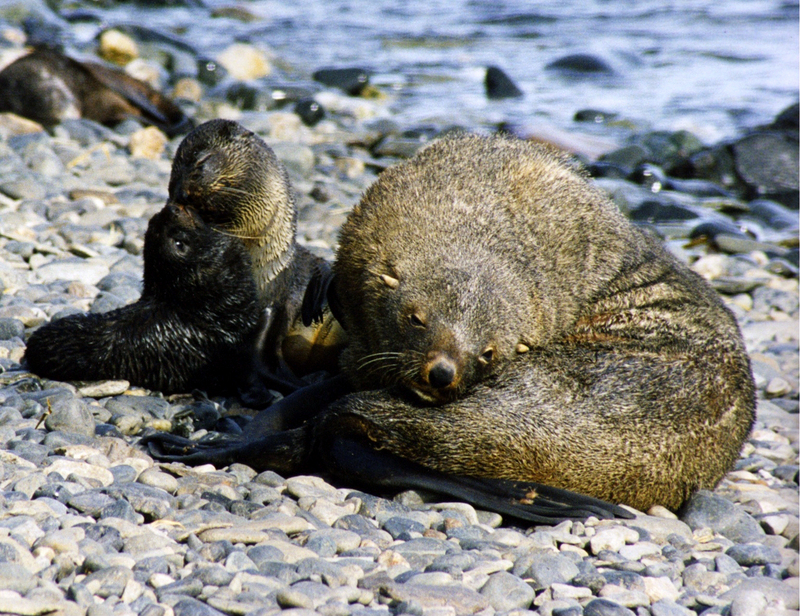|
| 질의: Mammal | 결과: 1344번째/3457 | |
Antarctic Fur Seal (Arctocephalus gazella) - Wiki
| 제목: | Antarctic Fur Seal (Arctocephalus gazella) - Wiki
| |

| 해상도: 1536x1182
파일크기: 1636748 Bytes
촬영일: 2007:10:31 10:09:15
등록시간: 2007:12:20 16:51:16
|
Antarctic Fur Seal
From Wikipedia, the free encyclopedia
Order: Carnivora
Suborder: Pinnipedia
Family: Otariidae
Subfamily: Arctocephalinae
[Photo] Antarctic Fur Seal (Arctocephalus gazella). at South Georgia Island. The image was taken by Mila Zinkova (http://home.comcast.net/~milazinkova/Fogshadow.html). The image is a scan of an old print. Copyright (C) 2007 Mila Zinkova
Permission is granted to copy, distribute and/or modify this document under the terms of the GNU Free Documentation License, Version 1.2 or any later version published by the Free Software Foundation; with no Invariant Sections, no Front-Cover Texts, and no Back-Cover Texts. A copy of the license is included in the section entitled "GNU Free Documentation License". |
The Antarctic Fur Seal (Arctocephalus gazella) is one of seven seals in the genus Arctocephalus. As its name suggests, the Antarctic Fur Seal is distributed in Antarctic waters. Around 95% of the world population breeds at South Georgia. It is named for the German naval vessel the SMS Gazelle which collected the first specimen from Kerguelen Island. The species is also known as the Kerguelen Fur Seal.
Physical description
This fur seal has a short and broad snout compared with others in the family. Adult males are dark brown in colour. Females and juveniles tend to be grey with a lighter underside. Colour patterns are highly variable, and some scientists believe that some hybridisation with subantarctic fur seals has occurred. Pups are dark brown, nearly black at birth. About one in 1000 Antarctic fur seals are pale 'blonde' variants.
Males are substantially larger (2 m, 200 kg) than females (1.35 m, 40 kg). Males live for about 15 years and females up to 25.
Antarctic Fur Seals appear to act alone when foraging and migrating. Males breed polygynously ??? a strong male may have more than a dozen female partners in a single season. Territories are established on breeding grounds in October to early November, when the musty-smelling males are extremely aggressive in defence of their harems. Females gestate for just over a year - giving birth in November or December. Pups are weaned at about month old. Juveniles may then spend several years in the water before returning to begin their breeding cycle.
The usual food supply is krill, and each Antarctic Fur seal eats about a ton of krill each year. Due to the enormous and growing populations of these seals, their food is a significant proportion of South Georgia's krill stocks.
Range and population
The Antarctic Fur Seal breeds in summer on islands ranging from South Georgia at 70° W round to about 80° E (Kerguelen Islands). Additionally there is a breeding ground at Macquarie Island, 165°E - south of New Zealand. All of these islands are between 45° S and 60° S. The animal's winter range is not known. During these long dark months, the seal spends its time almost surely close to the Antarctic ice ??? spending virtually its time at sea.
A population count is due in 2007 or 2008, and estimates can only be very rough until this is carried out. Best guesses suggest there may be two to four million individuals breeding at South Georgia and 15,000 at Heard Island. The concentrations at South Georgia are the densest aggregations of marine mammals on earth. Some people believe these populations have grown to such levels because the removal of whales by the intensive whaling of the 20th century left a surplus of krill. Other islands in Antarctic waters may have a few hundred to a thousand such seals.
Human interaction
The Antarctic Fur Seal was very heavily hunted in the eighteenth and nineteenth centuries for its pelt by sealers from the United States and the United Kingdom. By the early twentieth century, the seal was regarded as commercially extinct, and perhaps completely extinct. In fact a small population continued to exist, breeding on Bird Island in South Georgia. This colony has expanded rapidly over the course of a century. The current populations on the other Antarctic islands are believed to be off-shoots of this one colony.
The species is still protected by the governments in whose waters it resides (Australia, South Africa) and by the Convention for the Conservation of Antarctic Seals in waters south of 60° S. The animal is also listed in Appendix 2 of CITES. However some governments with interests in the Antarctic, for instance, the United Kingdom, say that some of these protections should be lifted as the species is causing damage to vulnerable Antarctic plants.
http://en.wikipedia.org/wiki/Antarctic_Fur_Seal
| The text in this page is based on the copyrighted Wikipedia article shown in above URL. It is used under the GNU Free Documentation License. You may redistribute it, verbatim or modified, providing that you comply with the terms of the GFDL. |
|
^o^
동물그림창고 똑똑전화 누리집
^o^
|
|